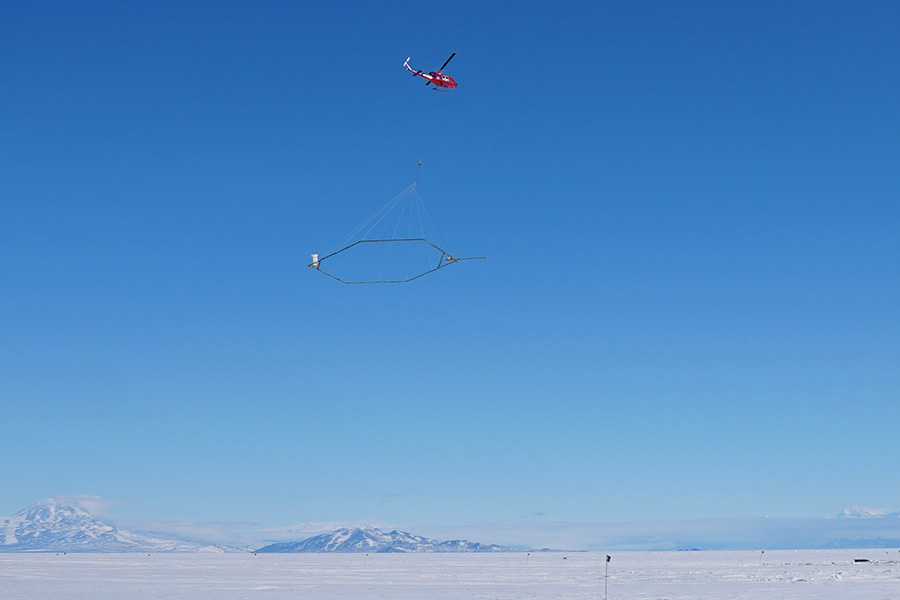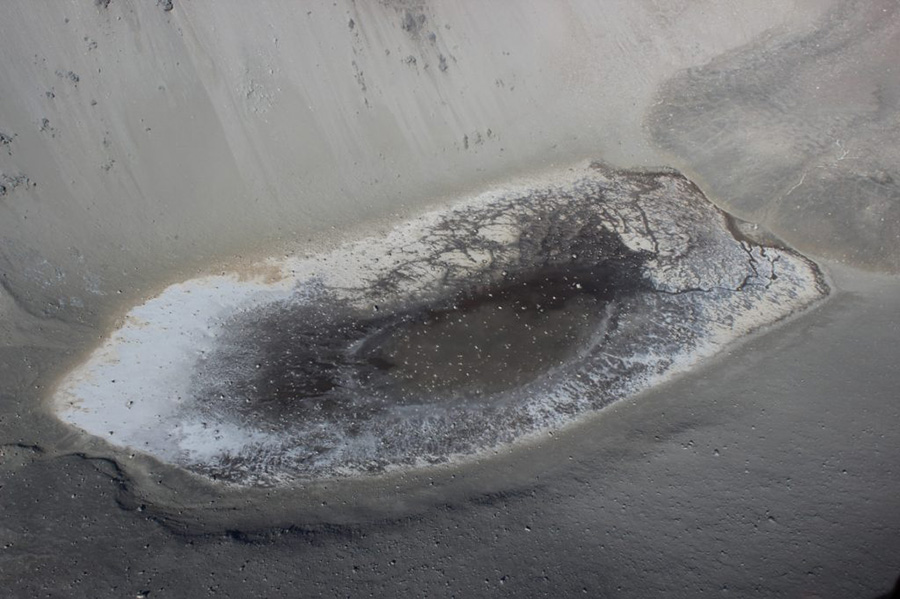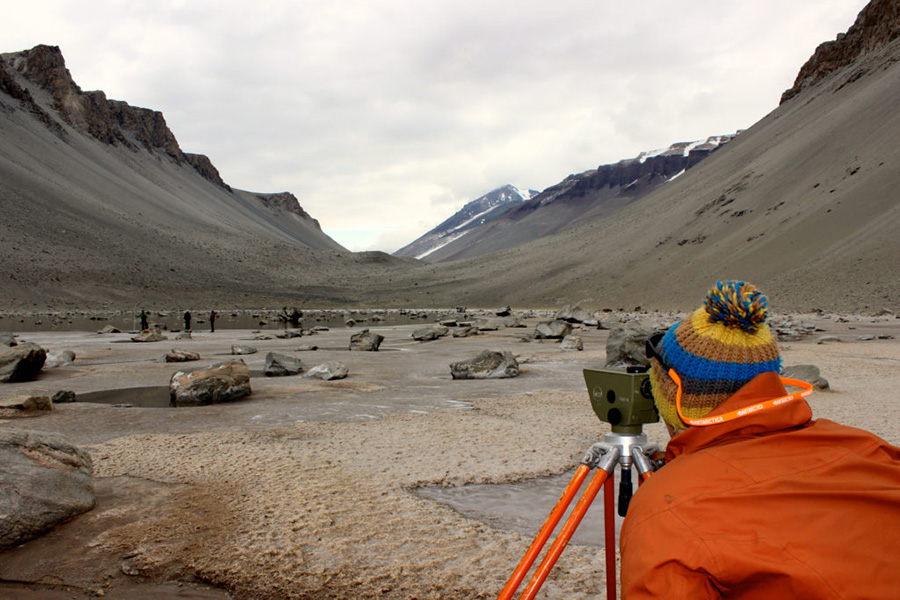Groundwater could connect two of Earth's saltiest bodies of waterLiquid brine permeates the ground below Antarctica's largest ice-free area, new research findsFebruary 06, 2023
Research conducted with airborne instruments shows the presence of salty, unfrozen groundwater in the bitterly cold rocks below the Antarctic surface. A new study detailing the findings suggests deep conduits for brine could exist throughout the Wright Valley in Antarctica's McMurdo Dry Valleys, potentially connecting two of Earth's saltiest bodies of water. Don Juan Pond is 10 times saltier than seawater — salty enough to remain liquid throughout the long polar winter. Nearby Lake Vanda is a “meromitic,” or layered, lake with a freshwater cap overlying salty water. The brine at the bottom of Lake Vanda is 3.5 times saltier than the ocean. Scientists have speculated about a groundwater connection between the two lakes since the 1960s without finding conclusive evidence. But airborne surveys of the Wright Valley during expeditions in 2011 and 2018, and a 2017 ground-based survey, revealed liquid hidden far below the surface. “It looks like a dry, rocky landscape, and yet your instruments are telling you that maybe 200 meters beneath you there's liquid brine,” said Hilary Dugan, a limnologist at the University of Wisconsin — Madison and lead author of the new study. The researchers can't conclude that the two lakes are linked, but the findings suggest Antarctica's groundwater system could be more complex than scientists previously thought. “I think that this is just the start of becoming aware of what processes could be happening there,” said Neil Foley, a geophysicist at the University of Montana Western and coauthor of the study. Antarctic lakes are good analogs for salt-rich ponds or cold subsurface lakes on other planets or moons, so lessons from this study may help planetary scientists devise probes to look for life beyond Earth, according to the researchers. “Everywhere we go, will go, and are going to look for life outside of planet Earth will be places that are way colder than planet Earth,” said Slawek Tulaczyk, a glaciologist at the University of California Santa Cruz and the lead scientist for the project. “Polar regions are a logical place to go and learn about how life could cope with coldness.” Extremely salty lakes in extremely cold placesWright Valley is part of the McMurdo Dry Valleys, the largest ice-free region of Antarctica. Located in the Transantarctic Mountains near the Ross Sea, the Dry Valleys are so named because they aren't covered by snow and haven't seen rain in two million years. At the western end of Wright Valley lies Don Juan Pond, one of the saltiest bodies of water on Earth. It's shallow and flat-bottomed, but it almost never freezes. “Don Juan Pond looks like a big puddle,” Dugan said. A few kilometers east of Don Juan Pond, Lake Vanda looks like any other frozen lake. The lake is fed by the Onyx River, the longest river in Antarctica, which flows only a few weeks each summer, because freshwater at the surface freezes during the rest of the year. “Lake Vanda has very cool ice,” Dugan said. “The ice can be up to three or four meters thick, and you can just see straight through it.” But the frozen lake is deceiving at the surface. Beneath the ice is 70 meters of liquid water, with a layer of warm, salty brine at the bottom. Because of its extreme saltiness, Don Juan Pond stays liquid even in temperatures as low as minus 40 or 50 degrees Celsius. Lake Vanda remains liquid because thick lake ice slows heat loss in the winter. Interestingly, the salt in both lakes is predominantly calcium chloride. “All of the other lakes in the Dry Valleys have sodium chloride, more like ocean water,” Dugan said. “It's a little odd.” The lakes' distinctive salt contents and geographical proximity led scientists to speculate for decades about an underground connection between them. Research in the 1970s and the decades afterward suggested a connection could exist between the two lakes, but progress slowed as researchers pursued surface water projects with easier access and simpler methods. But in the 2010s, Dugan, Tulaczyk and their colleagues revisited the problem. Airborne tools reveal liquid beneath the surfaceIn the new study, the researchers used an electromagnetic induction survey tool to probe for subsurface materials — like salty water — that conduct electricity. It's composed of a ring of copper coils about 20 meters in diameter and is so massive it has to be flown by a helicopter. 
Image Credit: Lars Jensen.
A helicopter crew conducts an airborne electromagnetic survey over Wright Valley in Antarctica.
The helicopter dangles the apparatus about 50 meters above the ground, while the instrument sends a transient electromagnetic field into the rock below. The signal penetrates rock up to 600 meters below the surface. If the signal encounters a conductive material, like brine, a secondary electromagnetic field arises. A receiver detects those secondary signals. “It's like ringing a tuning fork and listening for other tuning forks to ring back,” Foley said. Secondary signals indicate that brine is present below the surface. “Salty water is the only thing that would be conductive in this landscape,” Dugan said. “Everything else is frozen…it doesn't conduct electricity.” In 2011 and 2018, helicopter crews flew across the Wright Valley with the instrument hanging below, firing off 30 “pings” per second. They did find groundwater, but they weren't able to confirm a direct connection between lakes. “We couldn't conclusively say yes, and we couldn't conclusively say no,” Dugan said. Dugan explained that the ground between Don Juan Pond and Lake Vanda appears to be more solid rock than porous sediment, which means water has to percolate through tiny cracks and fissures instead of flowing as a large body of water. “Our tool can't tell between frozen sediment and a solid rock that only has a [little] brine percolating through it,” Tulaczyk said. Although the researchers couldn't conclusively say the two lakes are linked, the finding only deepens the mystery of these two unusual bodies of water. But according to Dugan, it's important to consider groundwater connectivity in frozen landscapes that are changing. “This is just one valley," Dugan said. "But if you think about Canada, the Arctic, and Russia, these frozen landscapes with millions of lakes, we're certainly going to see more groundwater and hydrology connectivity as permafrost starts to thaw.” This research is supported by the National Science Foundation, which manages the U.S. Antarctic Program. NSF-funded research in this story: Peter Doran, Louisiana State University, award 1643536; Jill Mikucki, University of Tennessee, award 1643687; Ross Virginia, Dartmouth College, award 1643775; Slawek Tulaczyk, University of California, Santa Cruz, award 1644187. |
"News about the USAP, the Ice, and the People"



For USAP Participants |
For The Public |
For Researchers and EducatorsContact UsU.S. National Science FoundationOffice of Polar Programs Geosciences Directorate 2415 Eisenhower Avenue, Suite W7100 Alexandria, VA 22314 Sign up for the NSF Office of Polar Programs newsletter and events. Feedback Form |




